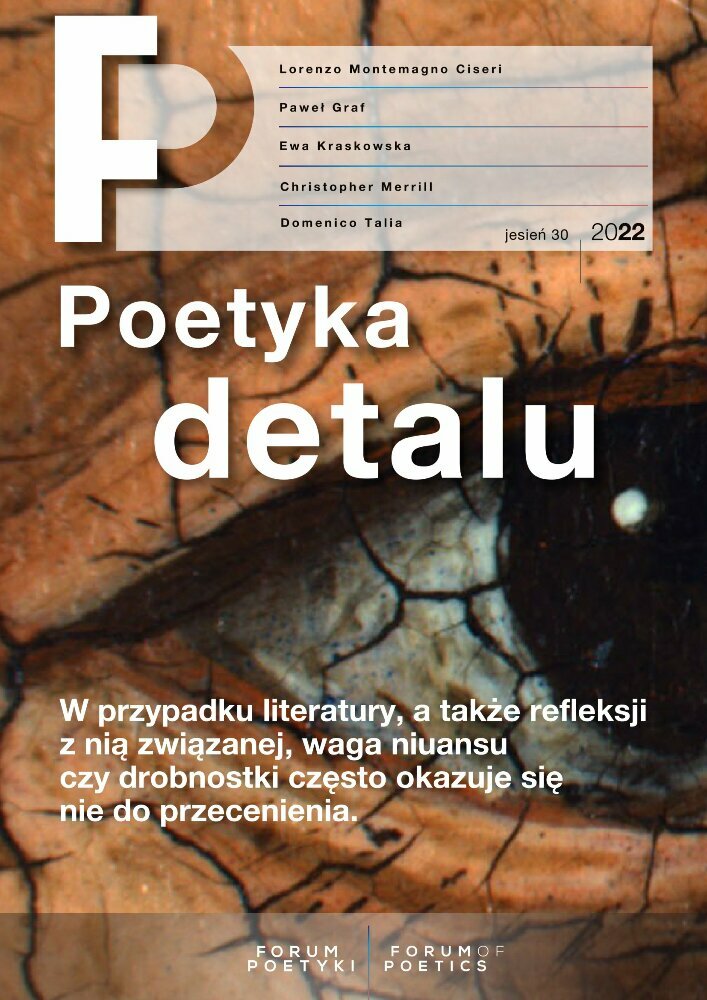Abstract
This article examines what role details and other similar artistic devices play in representing the Holocaust in contemporary Polish children’s literature. The focus on the detail often forces a shift in perspective, both in the fine arts and in literature. Focusing on prominent and meaningful details renders the story less direct, and the cruelty of history is revealed through gaps in the narrative. Details stand for the unsaid and refer the reader to extra-textual knowledge. Details also allow one to engage in a game of perspectives: by zooming in and out on specific scenes or events one, alternatively, renders them more or less important. Children’s books about the Holocaust are primarily meant to build memory and post-memory, and employ details to that end. Around and through details, the successive layers of stories may grow.
References
Arasse, Daniel. Detal. Historia malarstwa w zbliżeniu. Tłum. Anna Arno. Kraków: DodoEditor, 2013.
Balcerzan, Edward. Poezja polska w latach 1939–1968. Książka dla nauczycieli, studentów i uczniów. Warszawa: Wydawnictwa Szkolne i Pedagogiczne, 1998.
Chmielewska, Iwona. Pamiętnik Blumki. Poznań: Media Rodzina, 2011.
Grabowski, Andrzej Marek. Wojna na Pięknym Brzegu. Łódź: Wydawnictwo Literatura, 2019.
Jaromir, Adam, Cichowska, Gabriela, Ostatnie przedstawienie panny Esterki. Poznań: Media Rodzina, 2014.
Landau, Irena. Ostatnie piętro. Łódź: Wydawnictwo Literatura, 2015.
Piątkowska, Renata. Wszystkie moje mamy. Łódź: Wydawnictwo Literatura, 2018.
Shallcross, Bożena. Rzeczy i Zagłada. Kraków: Universitas, 2012
Sontag, Susan. O fotografii. Tłum. Sławomir Magala. Kraków: Wydawnictwo Karakter, 2009.
Tuszyńska, Agata, Chmielewska, Iwona. Mama zawsze wraca. Warszawa: Wydawnictwo Dwie Siostry, 2020.
Wądolny-Tatar, Katarzyna. „Synekdocha jako trop wizualny w książkowych ilustracjach dla dzieci (na przykładzie wybranych narracji słowa i obrazu o drugiej wojnie światowej)”. W: Literatura i inne sztuki w przestrzeni edukacyjnej dziecka, red. Alicja Ungerheuer-Gołąb, Urszula Kopeć, 161–173. Rzeszów: Wydawnictwo Uniwersytetu Rzeszowskiego, 2016.
Wójcik-Dudek, Małgorzata. W(y)czytać Zagładę. Praktyki postpamięci w polskiej literaturze XXI wieku dla dzieci i młodzieży. Katowice: Wydawnictwo Uniwersytetu Śląskiego, 2016
License
Copyright (c) 2022 Agnieszka Kwiatkowska

This work is licensed under a Creative Commons Attribution-NonCommercial-NoDerivatives 4.0 International License.
Authors of articles are responsible for securing the rights to other publications (texts, tables, drawings and other illustrations) quoted or reproduced in their texts.

